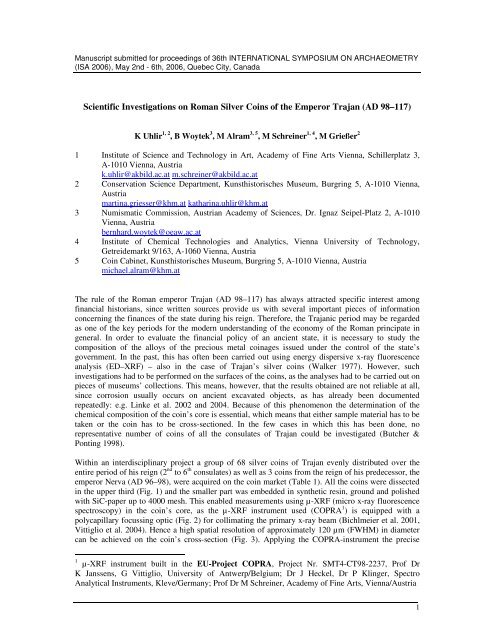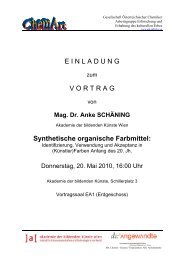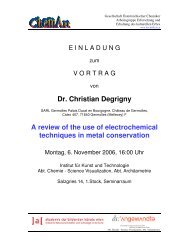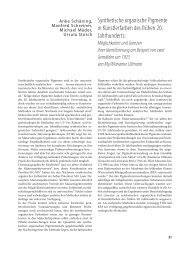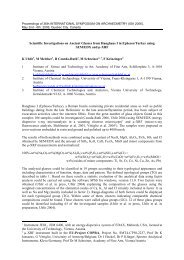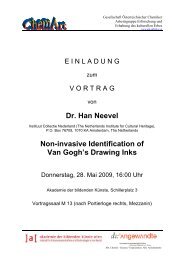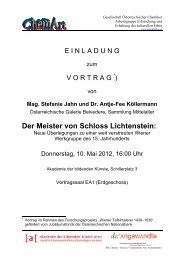Scientific Investigations on Roman Silver Coins of the Emperor Trajan
Scientific Investigations on Roman Silver Coins of the Emperor Trajan
Scientific Investigations on Roman Silver Coins of the Emperor Trajan
Create successful ePaper yourself
Turn your PDF publications into a flip-book with our unique Google optimized e-Paper software.
Manuscript submitted for proceedings <strong>of</strong> 36th INTERNATIONAL SYMPOSIUM ON ARCHAEOMETRY<br />
(ISA 2006), May 2nd - 6th, 2006, Quebec City, Canada<br />
<str<strong>on</strong>g>Scientific</str<strong>on</strong>g> <str<strong>on</strong>g>Investigati<strong>on</strong>s</str<strong>on</strong>g> <strong>on</strong> <strong>Roman</strong> <strong>Silver</strong> <strong>Coins</strong> <strong>of</strong> <strong>the</strong> <strong>Emperor</strong> <strong>Trajan</strong> (AD 98–117)<br />
K Uhlir 1, 2 , B Woytek 3 , M Alram 3, 5 , M Schreiner 1, 4 , M Grießer 2<br />
1 Institute <strong>of</strong> Science and Technology in Art, Academy <strong>of</strong> Fine Arts Vienna, Schillerplatz 3,<br />
A-1010 Vienna, Austria<br />
k.uhlir@akbild.ac.at m.schreiner@akbild.ac.at<br />
2 C<strong>on</strong>servati<strong>on</strong> Science Department, Kunsthistorisches Museum, Burgring 5, A-1010 Vienna,<br />
Austria<br />
martina.griesser@khm.at katharina.uhlir@khm.at<br />
3 Numismatic Commissi<strong>on</strong>, Austrian Academy <strong>of</strong> Sciences, Dr. Ignaz Seipel-Platz 2, A-1010<br />
Vienna, Austria<br />
bernhard.woytek@oeaw.ac.at<br />
4 Institute <strong>of</strong> Chemical Technologies and Analytics, Vienna University <strong>of</strong> Technology,<br />
Getreidemarkt 9/163, A-1060 Vienna, Austria<br />
5 Coin Cabinet, Kunsthistorisches Museum, Burgring 5, A-1010 Vienna, Austria<br />
michael.alram@khm.at<br />
The rule <strong>of</strong> <strong>the</strong> <strong>Roman</strong> emperor <strong>Trajan</strong> (AD 98–117) has always attracted specific interest am<strong>on</strong>g<br />
financial historians, since written sources provide us with several important pieces <strong>of</strong> informati<strong>on</strong><br />
c<strong>on</strong>cerning <strong>the</strong> finances <strong>of</strong> <strong>the</strong> state during his reign. Therefore, <strong>the</strong> <strong>Trajan</strong>ic period may be regarded<br />
as <strong>on</strong>e <strong>of</strong> <strong>the</strong> key periods for <strong>the</strong> modern understanding <strong>of</strong> <strong>the</strong> ec<strong>on</strong>omy <strong>of</strong> <strong>the</strong> <strong>Roman</strong> principate in<br />
general. In order to evaluate <strong>the</strong> financial policy <strong>of</strong> an ancient state, it is necessary to study <strong>the</strong><br />
compositi<strong>on</strong> <strong>of</strong> <strong>the</strong> alloys <strong>of</strong> <strong>the</strong> precious metal coinages issued under <strong>the</strong> c<strong>on</strong>trol <strong>of</strong> <strong>the</strong> state’s<br />
government. In <strong>the</strong> past, this has <strong>of</strong>ten been carried out using energy dispersive x-ray fluorescence<br />
analysis (ED–XRF) – also in <strong>the</strong> case <strong>of</strong> <strong>Trajan</strong>’s silver coins (Walker 1977). However, such<br />
investigati<strong>on</strong>s had to be performed <strong>on</strong> <strong>the</strong> surfaces <strong>of</strong> <strong>the</strong> coins, as <strong>the</strong> analyses had to be carried out <strong>on</strong><br />
pieces <strong>of</strong> museums’ collecti<strong>on</strong>s. This means, however, that <strong>the</strong> results obtained are not reliable at all,<br />
since corrosi<strong>on</strong> usually occurs <strong>on</strong> ancient excavated objects, as has already been documented<br />
repeatedly: e.g. Linke et al. 2002 and 2004. Because <strong>of</strong> this phenomen<strong>on</strong> <strong>the</strong> determinati<strong>on</strong> <strong>of</strong> <strong>the</strong><br />
chemical compositi<strong>on</strong> <strong>of</strong> <strong>the</strong> coin’s core is essential, which means that ei<strong>the</strong>r sample material has to be<br />
taken or <strong>the</strong> coin has to be cross-secti<strong>on</strong>ed. In <strong>the</strong> few cases in which this has been d<strong>on</strong>e, no<br />
representative number <strong>of</strong> coins <strong>of</strong> all <strong>the</strong> c<strong>on</strong>sulates <strong>of</strong> <strong>Trajan</strong> could be investigated (Butcher &<br />
P<strong>on</strong>ting 1998).<br />
Within an interdisciplinary project a group <strong>of</strong> 68 silver coins <strong>of</strong> <strong>Trajan</strong> evenly distributed over <strong>the</strong><br />
entire period <strong>of</strong> his reign (2 nd to 6 th c<strong>on</strong>sulates) as well as 3 coins from <strong>the</strong> reign <strong>of</strong> his predecessor, <strong>the</strong><br />
emperor Nerva (AD 96–98), were acquired <strong>on</strong> <strong>the</strong> coin market (Table 1). All <strong>the</strong> coins were dissected<br />
in <strong>the</strong> upper third (Fig. 1) and <strong>the</strong> smaller part was embedded in syn<strong>the</strong>tic resin, ground and polished<br />
with SiC-paper up to 4000 mesh. This enabled measurements using µ-XRF (micro x-ray fluorescence<br />
spectroscopy) in <strong>the</strong> coin’s core, as <strong>the</strong> µ-XRF instrument used (COPRA 1 ) is equipped with a<br />
polycapillary focussing optic (Fig. 2) for collimating <strong>the</strong> primary x-ray beam (Bichlmeier et al. 2001,<br />
Vittiglio et al. 2004). Hence a high spatial resoluti<strong>on</strong> <strong>of</strong> approximately 120 µm (FWHM) in diameter<br />
can be achieved <strong>on</strong> <strong>the</strong> coin’s cross-secti<strong>on</strong> (Fig. 3). Applying <strong>the</strong> COPRA-instrument <strong>the</strong> precise<br />
1 µ-XRF instrument built in <strong>the</strong> EU-Project COPRA, Project Nr. SMT4-CT98-2237, Pr<strong>of</strong> Dr<br />
K Janssens, G Vittiglio, University <strong>of</strong> Antwerp/Belgium; Dr J Heckel, Dr P Klinger, Spectro<br />
Analytical Instruments, Kleve/Germany; Pr<strong>of</strong> Dr M Schreiner, Academy <strong>of</strong> Fine Arts, Vienna/Austria<br />
1
positi<strong>on</strong>ing <strong>of</strong> <strong>the</strong> samples is d<strong>on</strong>e by using an electr<strong>on</strong>ically c<strong>on</strong>trolled xyz-sample stage and a CCDcamera<br />
in combinati<strong>on</strong> with a microscope (magnificati<strong>on</strong> up to 10x). Due to <strong>the</strong> additi<strong>on</strong>al applicati<strong>on</strong><br />
<strong>of</strong> a rotary stage a high reproducibility <strong>of</strong> <strong>the</strong> analysis can be achieved because all measurements can<br />
be performed under <strong>the</strong> same geometry. The measurement c<strong>on</strong>diti<strong>on</strong>s are listed in table 2; <strong>the</strong><br />
evaluati<strong>on</strong> <strong>of</strong> <strong>the</strong> x-ray spectra obtained was d<strong>on</strong>e using <strong>the</strong> s<strong>of</strong>tware WinAxil 4.0, versi<strong>on</strong> 4.1.2, <strong>of</strong><br />
Canberra Eurisys Benelux.<br />
Results<br />
All <strong>the</strong> coins investigated (except <strong>on</strong>e imitati<strong>on</strong>) c<strong>on</strong>sist <strong>of</strong> a silver/copper alloy with traces <strong>of</strong> lead and<br />
in some cases also gold. The silver c<strong>on</strong>tent <strong>of</strong> <strong>the</strong> coins is shown in Fig. 4. The chemical compositi<strong>on</strong><br />
<strong>of</strong> <strong>the</strong> <strong>Trajan</strong>ic coins <strong>of</strong> <strong>the</strong> 2 nd c<strong>on</strong>sulate is almost identical to that used during <strong>the</strong> reign <strong>of</strong> <strong>the</strong><br />
emperor Nerva, namely approximately 87% Ag and 13% Cu. In three coins <strong>of</strong> <strong>the</strong>se two periods a<br />
higher silver c<strong>on</strong>centrati<strong>on</strong> <strong>of</strong> approximately 93% could be determined. However, in <strong>the</strong> 3 rd c<strong>on</strong>sulate<br />
<strong>of</strong> <strong>Trajan</strong> <strong>the</strong> silver c<strong>on</strong>tent <strong>of</strong> <strong>the</strong> denarii drops to approximately 79% Ag and 21% Cu. The chemical<br />
compositi<strong>on</strong> remains at this value for his entire reign. In additi<strong>on</strong> <strong>on</strong>ly a small group <strong>of</strong> six objects<br />
showing a silver c<strong>on</strong>tent <strong>of</strong> approximately 93 % could be observed.<br />
Within <strong>the</strong> c<strong>on</strong>sulates III to VI <strong>on</strong>ly two coins <strong>of</strong> <strong>Trajan</strong> show similar chemical compositi<strong>on</strong>s to <strong>the</strong><br />
lower-silver coins <strong>of</strong> his 2 nd c<strong>on</strong>sulate or <strong>of</strong> <strong>the</strong> reign <strong>of</strong> Nerva (approximately 87% silver).<br />
Never<strong>the</strong>less, <strong>the</strong>y might as well be outliers bel<strong>on</strong>ging to <strong>on</strong>e <strong>of</strong> <strong>the</strong> two standards <strong>of</strong> fineness in use at<br />
this time. A full discussi<strong>on</strong> will be available so<strong>on</strong> in Uhlir et al. 2007.<br />
C<strong>on</strong>clusi<strong>on</strong><br />
The systematic investigati<strong>on</strong>s which could be carried out <strong>on</strong> cross-secti<strong>on</strong>s <strong>of</strong> 68 <strong>Trajan</strong>ic coins by<br />
using µ-XRF yield a clear and precise result c<strong>on</strong>cerning <strong>the</strong> chemical compositi<strong>on</strong> used for <strong>the</strong> denarii<br />
in <strong>Trajan</strong>’s reign:<br />
Whereas in <strong>the</strong> 2 nd c<strong>on</strong>sulate <strong>the</strong> specimens investigated show a silver c<strong>on</strong>tent similar to <strong>the</strong> period <strong>of</strong><br />
Nerva, a remarkable decrease in <strong>the</strong> amount <strong>of</strong> silver from approximately 87% to about 79% in<br />
<strong>Trajan</strong>’s denarii between <strong>the</strong> years AD 99 and AD 100 (sec<strong>on</strong>d and third c<strong>on</strong>sulate, respectively)<br />
could be determined: This was <strong>the</strong> standard alloy <strong>the</strong> <strong>Roman</strong> mint adhered to in <strong>the</strong> following periods<br />
until <strong>the</strong> end <strong>of</strong> <strong>Trajan</strong>’s reign (AD 117).<br />
A closer look at <strong>the</strong> historical background helps to explain <strong>the</strong> drastic change in <strong>the</strong> compositi<strong>on</strong> <strong>of</strong> <strong>the</strong><br />
alloy: When <strong>Trajan</strong> came into power in January <strong>of</strong> <strong>the</strong> year AD 98, he did not stay in <strong>the</strong> empire’s<br />
capital city Rome but in Germany being <strong>the</strong> governor (legatus Augusti pro praetore) <strong>of</strong> <strong>the</strong> <strong>Roman</strong><br />
province <strong>of</strong> Germania superior. After his accessi<strong>on</strong> to <strong>the</strong> thr<strong>on</strong>e, he did not return to Italy but<br />
remained in <strong>the</strong> nor<strong>the</strong>rn provinces <strong>of</strong> <strong>the</strong> Imperium <strong>Roman</strong>um for almost two years: He traveled<br />
al<strong>on</strong>g <strong>the</strong> rivers Rhine and Danube toge<strong>the</strong>r with his staff inspecting <strong>the</strong> troops <strong>of</strong> <strong>the</strong> <strong>Roman</strong> fr<strong>on</strong>tier<br />
provinces. It was <strong>on</strong>ly in <strong>the</strong> late autumn <strong>of</strong> AD 99 that <strong>Trajan</strong> entered Rome for <strong>the</strong> first time as an<br />
emperor. In AD 101, he left <strong>the</strong> capital again for a military campaign against <strong>the</strong> Dacians (in today’s<br />
<strong>Roman</strong>ia), for his “First Dacian War”, which ended with a <strong>Roman</strong> victory in AD 102.<br />
The results <strong>of</strong> <strong>the</strong> metallurgical analyses <strong>of</strong> <strong>the</strong> <strong>Trajan</strong>ic denarii tie in well with <strong>the</strong>se facts: The silver<br />
c<strong>on</strong>tent was reduced in AD 100, precisely when <strong>Trajan</strong> was in Rome for <strong>the</strong> first time during his reign.<br />
In this period, intense preparati<strong>on</strong>s for <strong>the</strong> Dacian campaign were doubtless being carried out. The<br />
<strong>Roman</strong> mint’s scope in reducing <strong>the</strong> silver c<strong>on</strong>tent <strong>of</strong> <strong>the</strong> denarii surely was to save m<strong>on</strong>ey and to<br />
relieve <strong>the</strong> state’s budget.<br />
Acknowledgement<br />
The authors gratefully acknowledge <strong>the</strong> financial support <strong>of</strong> this project by <strong>the</strong> Austrian Science Fund<br />
(FWF Project No. P17462, Finanzgeschichtliche Aspekte der traianischen Münzprägung).<br />
2
References<br />
Bichlmeier S, K Janssens, J Heckel, D Gibs<strong>on</strong>, P H<strong>of</strong>fmann & HM Ortner 2001: Comp<strong>on</strong>ent selecti<strong>on</strong><br />
for a compact micro-XRF spectrometer, X-Ray Spectrometry 30, 8–14<br />
Butcher K & M P<strong>on</strong>ting 1998: Atomic Absorpti<strong>on</strong> Spectrometry and <strong>Roman</strong> <strong>Silver</strong> <strong>Coins</strong>, in: A Oddy<br />
& M Cowell (eds.), Metallurgy in Numismatics, Vol. 4, (Royal Numismatic Society Special<br />
Publicati<strong>on</strong> 30) 308–334, L<strong>on</strong>d<strong>on</strong><br />
Linke R, M Schreiner, G Demortier, M Alram & H Winter 2004: The provenance <strong>of</strong> medieval silver<br />
coins: analysis with EDXRF, SEM/EDX and PIXE, in: K Janssens & R Van Grieken (eds.):<br />
Comprehensive Analytical Chemistry: Vol. XLII N<strong>on</strong>-destructive microanalysis <strong>of</strong> cultural<br />
heritage materials, Elsevier Amsterdam, 605–634<br />
Linke R, M Schreiner, H Winter & M Alram 2002: N<strong>on</strong>-destructive analysis <strong>of</strong> Austrian medieval<br />
silver coins by energy dispersive x-ray florescence, BAR Internati<strong>on</strong>al Series 1043 (II), 409–<br />
415<br />
Uhlir K, B Woytek, M Schreiner, M Alram & M Grießer 2007: Metallanalytische Forschungen zur<br />
Denarprägung Kaiser Traians (98–117 n. Chr.), Technologische Studien 4, Kunsthistorisches<br />
Museum Wien, in print<br />
Vittiglio G, S Bichlmeier, P Klinger, J Jeckel, W Fuzh<strong>on</strong>g, L Vincze, K Janssens, P Engström, A<br />
Rindby, K Dietrich, D Jembrih-Simbürger, M Schreiner, D Denis, A Lakdar & A Lamotte<br />
2004: A compact µ-XRF spectrometer for (in-situ) analysis <strong>of</strong> cultural heritage and forensic<br />
materials, Nuclear Instruments and Methods in Physics Research Secti<strong>on</strong> B 213, 693–698<br />
Walker DR 1977: The Metrology <strong>of</strong> <strong>the</strong> <strong>Roman</strong> <strong>Silver</strong> Coinage. Part II: from Nerva to Commodus,<br />
BAR Suppl. Ser. 22, Oxford<br />
Fig. 1: Coin No. 20, 4 th c<strong>on</strong>sulate <strong>of</strong> <strong>Trajan</strong><br />
intact dissected<br />
Fig. 2: Polycapillary focussing unit<br />
The primary x-ray beam is focussed within <strong>the</strong> approximately 300.000 bent glass capillaries due to<br />
total reflecti<strong>on</strong>. The beam diameter obtained is 120 µm FWHM (40 kV and 0.4 mA for Fe-Kα).<br />
3
Fig. 3: Cross-secti<strong>on</strong> <strong>of</strong> coin no. 27, measurement positi<strong>on</strong> 1 (<strong>of</strong> 5),<br />
showing a sample area <strong>of</strong> 2 x 1.5 mm<br />
Fig. 4: Graph <strong>of</strong> <strong>the</strong> silver c<strong>on</strong>tent <strong>of</strong> <strong>the</strong> analysed coins<br />
coin no. emperor c<strong>on</strong>sulate special characteristics<br />
1 - 3 Nerva<br />
4 - 11 <strong>Trajan</strong> II<br />
12 - 15 <strong>Trajan</strong> III<br />
16 - 20 <strong>Trajan</strong> IIII<br />
21 - 29 <strong>Trajan</strong> IIII victory issue<br />
30 - 37 <strong>Trajan</strong> V l<strong>on</strong>g legend<br />
38 - 56 <strong>Trajan</strong> V short legend<br />
57 - 68 <strong>Trajan</strong> VI<br />
69 <strong>Trajan</strong> provincial issue<br />
70 - 71 <strong>Trajan</strong> c<strong>on</strong>temporary imitati<strong>on</strong>s<br />
Table 1: <strong>Coins</strong> acquired <strong>on</strong> <strong>the</strong> coin market for analyses with sample preparati<strong>on</strong><br />
x-ray tube molybdenum anode<br />
tube voltage 35 kV<br />
tube current 0.8 mA<br />
acquisiti<strong>on</strong> time 200 s<br />
Table 2: µ-XRF measurement c<strong>on</strong>diti<strong>on</strong>s<br />
4


